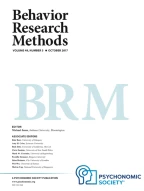Abstract
Exploratory factor analysis (EFA) is one of the most widely used statistical procedures in psychological research. It is a classic technique, but statistical research into EFA is still quite active, and various new developments and methods have been presented in recent years. The authors of the most popular statistical packages, however, do not seem very interested in incorporating these new advances. We present the program FACTOR, which was designed as a general, user-friendly program for computing EFA. It implements traditional procedures and indices and incorporates the benefits of some more recent developments. Two of the traditional procedures implemented are polychoric correlations and parallel analysis, the latter of which is considered to be one of the best methods for determining the number of factors or components to be retained. Good examples of the most recent developments implemented in our program are (1) minimum rank factor analysis, which is the only factor method that allows one to compute the proportion of variance explained by each factor, and (2) the simplimax rotation method, which has proved to be the most powerful rotation method available. Of these methods, only polychoric correlations are available in some commercial programs. A copy of the software, a demo, and a short manual can be obtained free of charge from the first author.
Article PDF
Similar content being viewed by others
Avoid common mistakes on your manuscript.
References
Anderson, R. D., &Rubin, H. (1956). Statistical inference in factor analysis. InProceedings of the 3rd Berkeley Symposium of Mathematical Statistics and Probability (Vol. 5, pp. 111–150). Berkeley: University of California Press.
Bentler, P. M. (1977). Factor simplicity index and transformations.Psychometrika,42, 277–295.
Browne, M. W. (2001). An overview of analytic rotation in exploratory factor analysis.Multivariate Behavioral Research,36, 111–150.
Browne, M. W., Cudeck, R., Tateneni, K., & Mels, G. (2004). CEFA: Comprehensive Exploratory Factor Analysis, Version 2.00 [Computer software and manual]. Available at http://quantrm2.psy .ohio-state.edu/browne/.
Clarke, M. R. B. (1970). A rapidly convergent method for maximumlikelihood factor analysis.British Journal of Mathematical & Statistical Psychology,23, 43–52.
Clarkson, D. B., &Jennrich, R. I. (1988). Quartic rotation criteria and algorithms.Psychometrika,53, 251–259.
Cureton, E. E., &Mulaik, S. A. (1975). The weighted varimax rotation and the promax rotation.Psychometrika,40, 183–195.
Eysenck, S. B. G., Eysenck, H. J., &Barrett, P. T. (1985). A revised version of the Psychoticism scale.Personality & Individual Differences,6, 21–29.
Fabrigar, L. R., Wegener, D. T., MacCallum, R. C., &Strahan, E. J. (1999). Evaluating the use of exploratory factor analysis in psychological research.Psychological Methods,4, 272–299.
Gorsuch, R. L. (1983).Factor analysis. Hillsdale, NJ: Erlbaum.
Hendrickson, A. E., &White, P. O. (1964). Promax: A quick method for rotation to oblique simple structure.British Journal of Statistical Psychology,17, 65–70.
Horn, J. L. (1965). A rationale and test for the number of factors in factor analysis.Psychometrika,30, 179–185.
Jöreskog, K. G. (1977). Factor analysis by least-squares and maximumlikelihood methods. In K. Enslein, A. Ralston, & H. S. Wilf (Eds.),Statistical methods for digital computers (pp. 125–153). New York: Wiley.
Kaiser, H. F. (1958). The varimax criterion for analytic rotation in factor analysis.Psychometrika,23, 187–200.
Kiers, H. A. L. (1994). Simplimax: An oblique rotation to an optimal target with simple structure.Psychometrika,59, 567–579.
Lorenzo-Seva, U. (1999). Promin: A method for oblique factor rotation.Multivariate Behavioral Research,34, 347–356.
Lorenzo-Seva, U. (2000). The weighted oblimin rotation.Psychometrika,65, 301–318.
Lorenzo-Seva, U. (2003). A factor simplicity index.Psychometrika,68, 49–60.
MacCallum, R. (1983). A comparison of factor analysis programs in SPSS, BMDP, and SAS.Psychometrika,48, 223–231.
McDonald, R. P. (1981). Constrained least squares estimators of oblique common factors.Psychometrika,46, 337–341.
McKeon, J. J. (1968).Rotation for maximum association between factors and tests. Unpublished manuscript, George Washington University.
Mislevy, R. J., &Bock, R. D. (1990).BILOG 3: Item analysis and test scoring with binary logistic models. Mooresville, IN: Scientific Software.
Mulaik, S. A. (1972).The foundations of factor analysis. New York: McGraw-Hill.
Shapiro, A., &ten Berge, J. M. F. (2002). Statistical inference of minimum rank factor analysis.Psychometrika,67, 79–94.
ten Berge, J. M. F., &Hofstee, W. K. B. (1999). Coefficients alpha and reliabilities of unrotated and rotated components.Psychometrika,64, 83–90.
ten Berge, J. M. F., &Kiers, H. A. L. (1991). A numerical approach to the exact and the approximate minimum rank of a covariance matrix.Psychometrika,56, 309–315.
ten Berge, J. M. F., Krijnen, W., Wansbeek, T., &Shapiro, A. (1999). Some new results on correlation-preserving factor scores prediction methods.Linear Algebra & Its Applications,289, 311–318.
ten Berge, J. M. F., &Nevels, K. (1977). A general solution to Mosier’s oblique Procrustes problem.Psychometrika,42, 593–600.
Tucker, L. R. (1951).A method for synthesis of factor analysis studies (Personnel Research Section Report No. 984). Washington, DC: U.S. Department of the Army.
Velicer, W. F. (1976). Determining the number of components from the matrix of partial correlations.Psychometrika,41, 321–327.
Yates, A. (1987).Multivariate exploratory data analysis: A perspective on exploratory factor analysis. Albany: State University of New York Press.
Author information
Authors and Affiliations
Corresponding author
Additional information
This research was supported by Grant SEC2001-3821-C05-C02 from the Spanish Ministry of Science and Technology with the collaboration of the European Fund for the Development of Regions.
Rights and permissions
About this article
Cite this article
Lorenzo-Seva, U., Ferrando, P.J. FACTOR: A computer program to fit the exploratory factor analysis model. Behavior Research Methods 38, 88–91 (2006). https://doi.org/10.3758/BF03192753
Received:
Accepted:
Issue Date:
DOI: https://doi.org/10.3758/BF03192753
